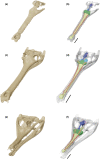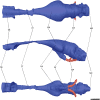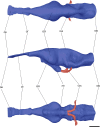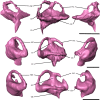Neuroanatomy of the crocodylian Tomistoma dowsoni from the Miocene of North Africa provides insights into the evolutionary history of gavialoids
- PMID: 36929596
- PMCID: PMC10273334
- DOI: 10.1111/joa.13846
Neuroanatomy of the crocodylian Tomistoma dowsoni from the Miocene of North Africa provides insights into the evolutionary history of gavialoids
Abstract
The interrelationships of the extant crocodylians Gavialis gangeticus and Tomistoma schlegelii have been historically disputed. Whereas molecular analyses indicate a sister taxon relationship between these two gavialoid species, morphological datasets typically place Gavialis as the outgroup to all other extant crocodylians. Recent morphological-based phylogenetic analyses have begun to resolve this discrepancy, recovering Gavialis as the closest living relative of Tomistoma; however, several stratigraphically early fossil taxa are recovered as closer to Gavialis than Tomistoma, resulting in anomalously early divergence timings. As such, additional morphological data might be required to resolve these remaining discrepancies. 'Tomistoma' dowsoni is an extinct species of gavialoid from the Miocene of North Africa. Utilising CT scans of a near-complete, referred skull, we reconstruct the neuroanatomy and neurosensory apparatus of 'Tomistoma' dowsoni. Based on qualitative and quantitative morphometric comparisons with other crocodyliforms, the neuroanatomy of 'Tomistoma' dowsoni is characterised by an intermediate morphology between the two extant gavialoids, more closely resembling Gavialis. This mirrors the results of recent studies based on the external anatomy of these three species and other fossil gavialoids. Several neuroanatomical features of these species appear to reflect ecological and/or phylogenetic signals. For example, the 'simple' morphology of their neurosensory apparatus is broadly similar to that of other long and narrow-snouted (longirostrine), aquatic crocodyliforms. A dorsoventrally short, anteroposteriorly long endosseous labyrinth is also associated with longirostry. These features indicate that snout and skull morphology, which are themselves partly constrained by ecology, exert an influence on neuroanatomical morphology, as has also been recognised in birds and turtles. Conversely, the presence of a pterygoid bulla in Gavialis and several extinct gavialoids, and its absence in Tomistoma schlegelii, could be interpreted as a phylogenetic signal of crocodylians more closely related to Gavialis than to Tomistoma. Evaluation of additional fossil gavialoids will be needed to further test whether these and other neuroanatomical features primarily reflect a phylogenetic or ecological signal. By incorporating such previously inaccessible information of extinct and extant gavialoids into phylogenetic and macroecological studies, we can potentially further constrain the clade's interrelationships, as well as evaluate the timing and ecological association of the evolution of these neuroanatomical features. Finally, our study supports recent phylogenetic analyses that place 'Tomistoma' dowsoni as being phylogenetically closer to Gavialis gangeticus than to Tomistoma schlegelii, indicating the necessity of a taxonomic revision of this fossil species.
Keywords: Tomistominae; computed tomography; crocodylian; ecomorphology; gharial; morphometrics neuroanatomy.
© 2023 The Authors. Journal of Anatomy published by John Wiley & Sons Ltd on behalf of Anatomical Society.
Figures









References
-
- Ballell, A. , Moon, B.C. , Porro, L.B. , Benton, M.J. & Rayfield, E.J. (2019) Convergence and functional evolution of longirostry in crocodylomorphs. Palaeontology, 62, 867–887.
-
- Barrios, F. , Bona, P. , PAULINA‐Carabajal, A. , Leardi, J.M. , Holliday, C.M. & Lessner, E.J. (2023) An overview on the crocodylomorpha cranial neuroanatomy: variability, morphological patterns and paleobiological implications. In: Dozo, M.T. , Pualina‐Carabjal, A. , Macrini, T.E. & Walsh, S. (Eds.) Paleoneurology of amniotes. Cham: Springer Nature, pp. 213–266.
-
- Bona, P. , Degrange, F.J. & Fernández, M.S. (2013) Skull anatomy of the bizarre crocodylian Mourasuchus nativus (Alligatoridae, Caimaninae). The Anatomical Record, 296, 227–239. - PubMed
-
- Bona, P. , Paulina‐Carabajal, A. & Gasparini, Z. (2015) Neuroanatomy of Gryposuchus neogaeus (Crocodylia, Gavialoidea): a first integral description of the braincase and endocranial morphological variation in extinct and extant gavialoids. Earth and Environmental Science Transactions of the Royal Society of Edinburgh, 106, 235–246.
Publication types
MeSH terms
Grants and funding
LinkOut - more resources
Full Text Sources
Research Materials

